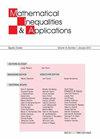离散Cesàaro算子的范数减去恒等式
IF 0.7
4区 数学
Q2 MATHEMATICS
引用次数: 5
摘要
当1<p≤2时,C−I在l上的范数(其中C是Cesàro算子)被证明是1/(p−1)。这证实了詹姆逊最近的一个猜想。当2<p<∞时,C−I在l上的范数也被确定。这两部分共同回答了G.Bennett在1996年提出的一个问题。连续情况下的算子范数,Hardy的平均算子减恒等式,已经为人所知。离散和连续情况下的规范是一致的。Cesàro算子C将序列(xn)映射到(yn),其中yn=1 n n本文章由计算机程序翻译,如有差异,请以英文原文为准。
Norm of the discrete Cesàaro operator minus identity
The norm of C−I on l, where C is the Cesàro operator, is shown to be 1/(p − 1) when 1 < p ≤ 2. This verifies a recent conjecture of G. J. O. Jameson. The norm of C − I on l is also determined when 2 < p < ∞. The two parts together answer a question raised by G. Bennett in 1996. Operator norms in the continuous case, Hardy’s averaging operator minus identity, are already known. Norms in the discrete and continuous cases coincide. The Cesàro operator, C, maps a sequence (xn) to (yn), where yn = 1 n n
求助全文
通过发布文献求助,成功后即可免费获取论文全文。
去求助
来源期刊
CiteScore
2.30
自引率
10.00%
发文量
59
审稿时长
6-12 weeks
期刊介绍:
''Mathematical Inequalities & Applications'' (''MIA'') brings together original research papers in all areas of mathematics, provided they are concerned with inequalities or their role. From time to time ''MIA'' will publish invited survey articles. Short notes with interesting results or open problems will also be accepted. ''MIA'' is published quarterly, in January, April, July, and October.

 求助内容:
求助内容: 应助结果提醒方式:
应助结果提醒方式:


